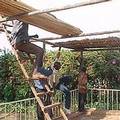 拉姆努(Carla Lamunu)靠著在鄰居家的花園做工,來勉強維持生活;因為她知道如果不工作的話,那一天就很有可能沒得吃。
拉姆努(Carla Lamunu)靠著在鄰居家的花園做工,來勉強維持生活;因為她知道如果不工作的話,那一天就很有可能沒得吃。
她渴望十年前在做紙莎草睡墊生意時的生活,那時經營狀況不錯,社區的每一個人也都會使用睡墊。拉姆努說:「製作睡墊是相當低成本的行業,只需要購買西波爾麻線就能縫製了。且縫製3個睡墊只要100先令烏干達貨幣──相當於美金5分錢的成本。」
拉姆努和其他製作睡墊的人一樣,一大早起床、走半公里路到附近的沼澤,去尋找需要用的紙莎草蘆稈。
一般可以從在走廊推疊整齊的紙莎草堆以及陳曬的數量,來猜測一個家庭是否富裕。但拉姆努表示,「這個情況已經改觀了。」
近幾年來,附近那些拉姆努常去摘取紙莎草的沼澤地全都被破壞了,而沒有蘆稈可撿的情況導致她無法製作睡墊。 在古盧附近的Kolo Quarters地區,曾是購買品質優良睡墊的最佳場所,但如今卻是泥濘遍地、又充滿了簡陋的茅草屋,居住著那些因政府和聖主反抗軍內戰而被迫遷移的人們。
幾年前,隨著人潮陸續湧入古盧以及駐紮在周圍的營地,讓拉姆努失去她原本的生活,必須面對戰後造成的一片荒蕪。
許多新來到的人也開始製作並販售價格低廉的睡墊,因而引發當地商業競爭,讓紙莎草供給逐漸枯竭。
拉姆努說,「有些本國難民也開始在沼澤區邊緣耕作,而且為了要種植農作物,很快就有一些人開始砍掉紙莎草。」 「沒有任何東西阻止這個情況發生,」她說道,「因為沼澤地區並不屬於任何人持有,另外這樣做能讓許多家庭藉其維持生計也是一個原因所在。」
而對於這樣的情況,拉姆努並不是唯一受到影響的人。曾經也是經營紙莎草經銷的歐克羅(George Okello)如今身體虛弱又身受結核病之苦。但由於種在當地區域的紙莎草被砍掉後,也讓他無法再賺錢買食物了。
歐克羅哀悼著那個曾經讓他擁有穩定收入來源、如今卻已失敗收場的生意;他表示,「懶惰或不經心才是唯一會造成失敗的因素。」 「廣大的沼澤區現在已被破壞殆盡,」歐克洛說,「只有身體健壯的人才能經過遠距離長途跋涉,去尋找新鮮的紙莎草。」
根據1995年烏干達憲章說道,禁止私人擁有沼澤地區。萬一有任何人想在沼澤區內從事營運活動,必須先獲得法律許可-也就是會先評估該活動是否會破壞環境後,再由烏干達國家環境管理機構負責處理授權問題。
之後獲准在沼澤地區內或周圍營運的活動必須和沼澤地區保持30公尺的距離,且不能釋出有毒汙染物質。
然而,這些法律只存在於理論上,並未在烏干達北部地區內強制執行。
Carla Lamunu survives on the living she ekes out from toiling in the gardens of her neighbor, knowing that if she doesn't work, she probably won't eat that day.
She longs for the life she had a decade ago, when she operated a lively business selling papyrus sleeping mats, which were used by everyone in the area at the time.
Making mats was a low-cost enterprise that only required the purchase of sisal threads to sew the mats together, said Lamunu. For just 100 Ugandan schillings, the equivalent of about five US cents, she could stitch together three mats.
Like other mat makers, Lamunu used to get up early in the morning and walk a half kilometre to a nearby swamp to find the papyrus reeds she needed.
A family's wealth could be guessed by the piles of papyrus neatly stacked by the verandas, and the amount spread out to dry.
But that's no longer the case, said Lamunu.
In recent years, the nearby wetlands where she used to pick papyrus have been all but destroyed, leaving her with no reeds with which to make her mats.
Her Kolo Quarters neighborhood in the Gulu district, once known as the best place to buy quality sleeping mats, is now crowded with mud and thatch huts, home to people displaced by the war between the government and the Lord's Resistance Army.
The loss of her livelihood began years ago as people streamed into Gulu and the camps that surrounded it, fleeing the ravages of the conflict.
Many of the newcomers began to make and sell the popular mats, creating competition and causing the papyrus supply to become depleted.
Lamunu said that some of the internal refugees also began to farm at the edges of the swamp, and soon many started to cut down the papyrus to make way for crops.
Nothing was done to stop what was happening, she said, because the swamp lands were unclaimed and also because it gave families a means of survival.
Lamunu was not the only one affected.
George Okello, who is also a former dealer in papyrus mats, is frail and suffers from tuberculosis. He's no longer able to make the money he needs to buy food, because the papyrus which used to grow in the area is gone.
Okello mourned the loss of his business, which once was a highly dependable source of income. The only way to lose was through laziness or carelessness, he said.
Now vast areas of the swamps have been destroyed, he said, and only the able-bodied can trek the long distances one must travel to find fresh reeds.
According to the 1995 constitution of Uganda, private ownership of wetlands is prohibited. Anyone operating in a wetland is legally required to have a permit, which is granted by the National Environmental Management Authority, after an assessment is done to determine whether the proposed activity would damage the environment.
Permitted activities in and around wetlands must take place 30 metres away from them and not release toxic pollutants.
However, while these laws exist in theory, they are not enforced in practice in the north of the country.




